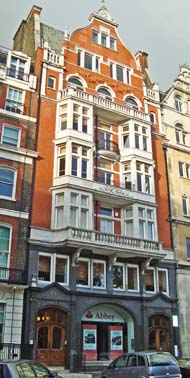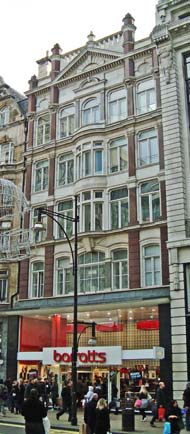Royal Orthopaedic Hospital
15 Hanover Square, W1S 1HS
Medical
dates:
Medical
character:
Specialist
The Infirmary for the Cure of
Club Foot and Other Contractions was founded in 1838 by William John Little
(1810-1894), a surgeon who himself had suffered from club foot caused
by polio contracted at the age of 4 years. Little had qualified
as a surgeon in 1832. He discovered that a surgeon in Hanover, Louis Stromeyer
(1804-1876), was curing certain foot deformities by cutting the
Achilles tendon with a narrow-bladed knife introduced through a tiny
puncture in the skin. Little visited Stromeyer, who performed a
subcutaneous tenotomy on his club foot and gradually corrected the
deformity. Stromeyer also gave Little the opportunity to perform
the operation on other patients.
Little returned to England and performed the first subcutaneous tenotomy in London on 20th February 1837. In 1839 he published his treatise Club Foot and Analogous Distortions. In the same year he was elected Assistant Physician to the London Hospital. Little's friends and colleagues urged him to found an institution for the cure of such deformities and an Appeal for funds was launched. This proved successful and No. 6 Bloomsbury Square was bought and adapted for use as a hospital. The property - a 4-storey house with a basement - had once been the family home of the writer Isaac D'Israeli (1766-1848), the father of the politician Benjamin Disraeli (1804-1881).
The Infirmary for the Cure of Club Foot and Other Contractions opened on 1st July 1840, the first hospital to treat patients crippled by their disability. However, the Duke of Bedford, the freeholder of the property, objected to the name plaque on the building, and so the name was changed to the Orthopaedic Institution. The word 'orthopaedic' is derived from two Greek words - orthos (straight) and paidion (child) - and had first been used in 1741 by the French physician Nicolas Andry (1658-1742).
At first only out-patients were seen, but a few months later two 3-bedded wards opened for in-patients.
In 1844 Little resigned from the medical staff but, despite consequent management turmoil, by 1845 the Institution had acquired the Queen's patronage and her permission to be renamed the Royal Orthopaedic Hospital.
By 1849 the Hospital had 36 beds, but the premises were becoming overcrowded.
In 1855, with the existing lease soon to expire, the Hospital's committee purchased the freehold of No. 15 Hanover Square, backing onto No. 297 Oxford Street. The Hospital moved to the new premises in March 1856, which had an initial 40 beds (the nurses were never off-duty there, for they slept on the wards).
By the 1890s, when the Hospital had 50 beds, the state of the Georgian building was deteriorating, as were the Hospital's finances. In 1899, after an outbreak of fever, a brief closure permitted some necessary remedial sanitary work at a cost of £2,000, but without - unaffordable - complete redevelopment of the building.
The Hospital re-opened in November 1899. The wards (the largest of which had 10 beds) had been refloored with blocks of polished wood. The walls, which had been wallpapered, had been stripped and painted a salmon colour, then varnished so that they could be washed down in future. The woodwork was painted a peacock blue. The bed quilts were of crimson woollen material, which unfortunately turned scarlet when washed. The nursing staff consisted of a Matron, 4 day nurses and a night nurse.
The Hospital's committee decided that the best course for the future of the Hospital, however, could be to sell what was now a very valuable West End site and rebuild elsewhere.
By 1903 plans were completed, a site in Coram Street was acquired and building work began for a new 60-bed purpose-built hospital. However, the construction was suspended as schemes for amalgamation were in the air. An initiative, led by the King's Fund, aimed to rationalise the provision of orthopaedic services within London. The site of the National Orthopaedic Hospital in Bolsover Street was to be the central London base, while a convalescent home would be established in a northern suburb. The plan was welcomed by both the Royal and the National Orthopaedic Hospitals, but rejected by the City Orthopaedic Hospital in Hatton Garden, whose buildings had recently been refurbished.
In 1904 the Hospital moved to No. 55 Bolsover Street and, in 1905, amalgamated with the National Orthopaedic Hospital to become the Royal National Orthopaedic Hospital for the Treatment and Cure of all Crippled and Deformed Patients. The funds from the sale of the Hanover Square site were put to use in the major rebuilding programme for the Bolsover Street premises.
Present status (November 2009)
The Hospital building has long since been demolished and replaced. The site is now occupied by commercial premises.
Little returned to England and performed the first subcutaneous tenotomy in London on 20th February 1837. In 1839 he published his treatise Club Foot and Analogous Distortions. In the same year he was elected Assistant Physician to the London Hospital. Little's friends and colleagues urged him to found an institution for the cure of such deformities and an Appeal for funds was launched. This proved successful and No. 6 Bloomsbury Square was bought and adapted for use as a hospital. The property - a 4-storey house with a basement - had once been the family home of the writer Isaac D'Israeli (1766-1848), the father of the politician Benjamin Disraeli (1804-1881).
The Infirmary for the Cure of Club Foot and Other Contractions opened on 1st July 1840, the first hospital to treat patients crippled by their disability. However, the Duke of Bedford, the freeholder of the property, objected to the name plaque on the building, and so the name was changed to the Orthopaedic Institution. The word 'orthopaedic' is derived from two Greek words - orthos (straight) and paidion (child) - and had first been used in 1741 by the French physician Nicolas Andry (1658-1742).
At first only out-patients were seen, but a few months later two 3-bedded wards opened for in-patients.
In 1844 Little resigned from the medical staff but, despite consequent management turmoil, by 1845 the Institution had acquired the Queen's patronage and her permission to be renamed the Royal Orthopaedic Hospital.
By 1849 the Hospital had 36 beds, but the premises were becoming overcrowded.
In 1855, with the existing lease soon to expire, the Hospital's committee purchased the freehold of No. 15 Hanover Square, backing onto No. 297 Oxford Street. The Hospital moved to the new premises in March 1856, which had an initial 40 beds (the nurses were never off-duty there, for they slept on the wards).
By the 1890s, when the Hospital had 50 beds, the state of the Georgian building was deteriorating, as were the Hospital's finances. In 1899, after an outbreak of fever, a brief closure permitted some necessary remedial sanitary work at a cost of £2,000, but without - unaffordable - complete redevelopment of the building.
The Hospital re-opened in November 1899. The wards (the largest of which had 10 beds) had been refloored with blocks of polished wood. The walls, which had been wallpapered, had been stripped and painted a salmon colour, then varnished so that they could be washed down in future. The woodwork was painted a peacock blue. The bed quilts were of crimson woollen material, which unfortunately turned scarlet when washed. The nursing staff consisted of a Matron, 4 day nurses and a night nurse.
The Hospital's committee decided that the best course for the future of the Hospital, however, could be to sell what was now a very valuable West End site and rebuild elsewhere.
By 1903 plans were completed, a site in Coram Street was acquired and building work began for a new 60-bed purpose-built hospital. However, the construction was suspended as schemes for amalgamation were in the air. An initiative, led by the King's Fund, aimed to rationalise the provision of orthopaedic services within London. The site of the National Orthopaedic Hospital in Bolsover Street was to be the central London base, while a convalescent home would be established in a northern suburb. The plan was welcomed by both the Royal and the National Orthopaedic Hospitals, but rejected by the City Orthopaedic Hospital in Hatton Garden, whose buildings had recently been refurbished.
In 1904 the Hospital moved to No. 55 Bolsover Street and, in 1905, amalgamated with the National Orthopaedic Hospital to become the Royal National Orthopaedic Hospital for the Treatment and Cure of all Crippled and Deformed Patients. The funds from the sale of the Hanover Square site were put to use in the major rebuilding programme for the Bolsover Street premises.
Present status (November 2009)
The Hospital building has long since been demolished and replaced. The site is now occupied by commercial premises.


St John's House, No. 15 Hanover Square (left) and No. 297 Oxford Street (once the back of the Hanover Square building), sometimes given as an alternative address for the Hospital.
(Author unstated) 1899 The Royal Orthopaedic Hospital. Nursing Record and Hospital World, 18th November, 417.
(Author unstated) 1904 Reflections from a Board Room Mirror. The Royal Orthopaedic Hospital. British Journal of Nursing, 26th March, 255.
(Author unstated) 1919 Editorial. Shorter hours for nurses. British Journal of Nursing, 22nd February, 115.
Barton NJ 2000 The growth of orthopaedics in Great Britain - Part I. Current Orthopaedics 14, 61-72.
Borsay A 2006 Disciplining disabled bodies: the development of orthopaedic medicine in Britain, c.1800-1939. In: Turner DM, Stagg K (eds) Social Histories of Disability and Deformity. London, Routledge.
Cholmeley JA 1985 History of the Royal National Orthopaedic Hospital. London, Chpman and Hall Medical.
Rocyn Jones A 1969. The British Orthopaedic Association. Journal of Bone and Joint Surgery 51-B, 1-3.
www.aim25.ac.uk
www.bartsandthelondon.nhs.uk
www.ucl.ac.uk
www.victorianlondon.org
Return to home page